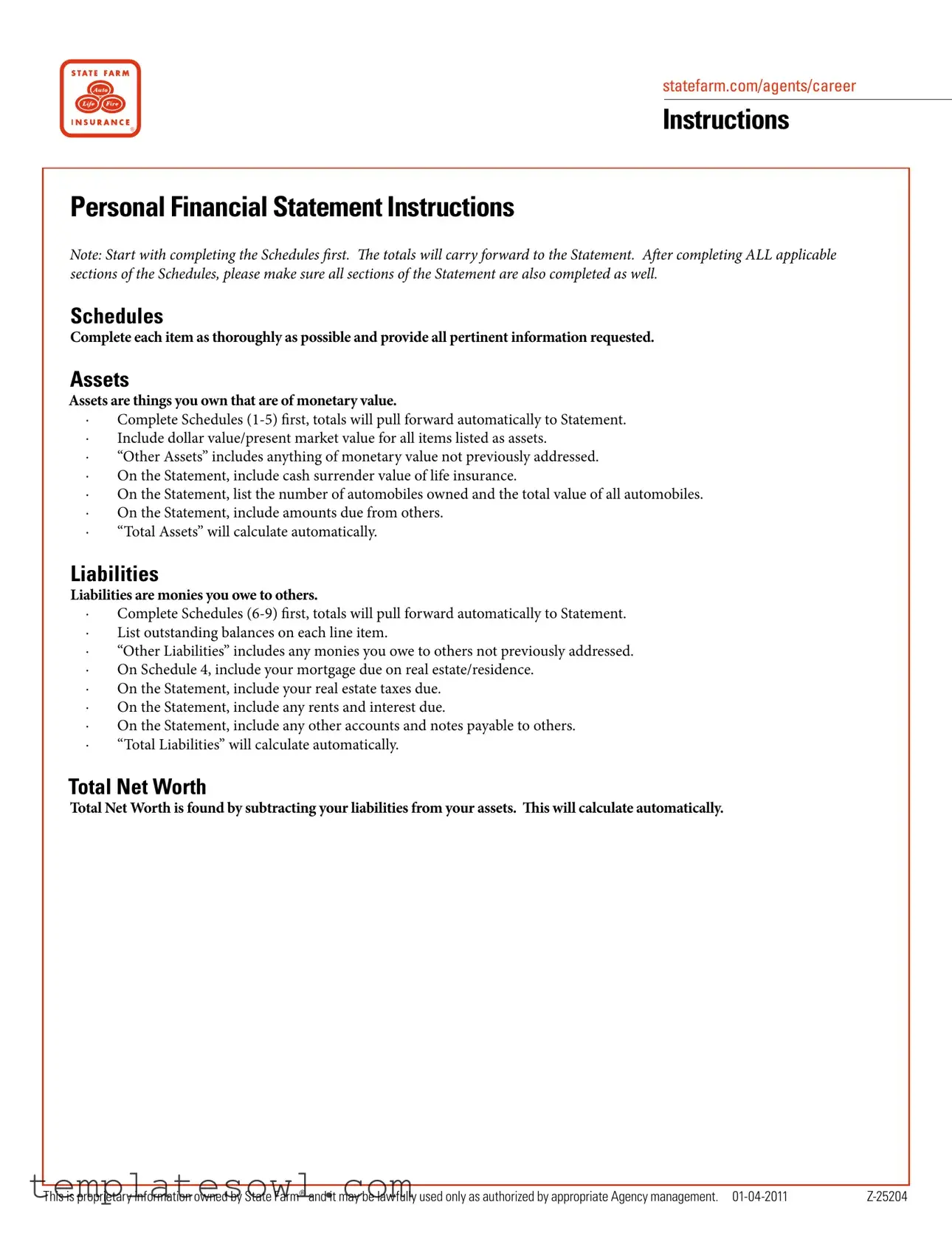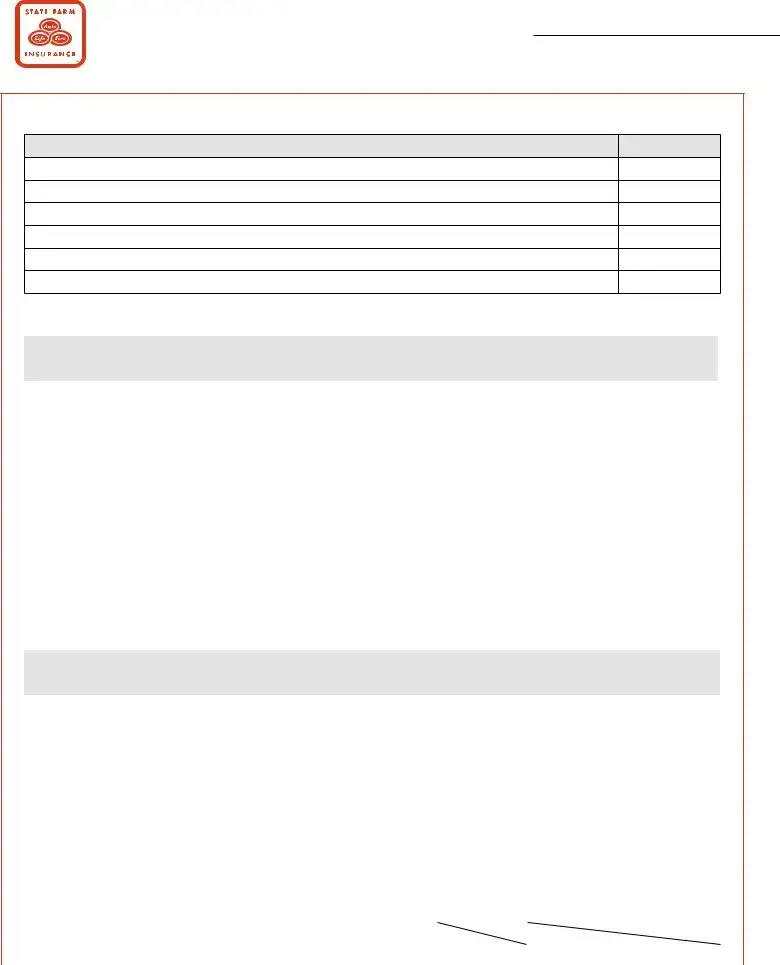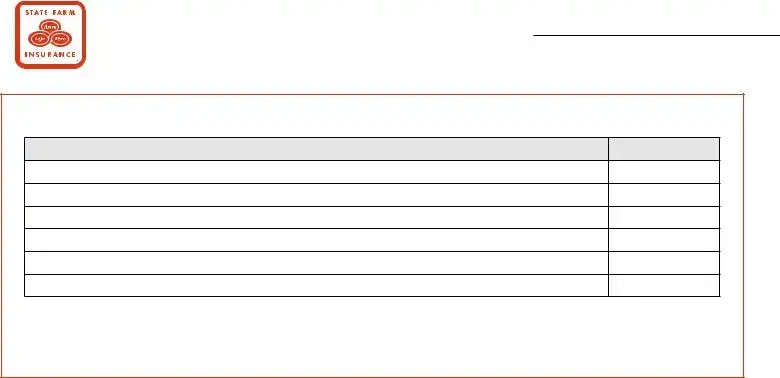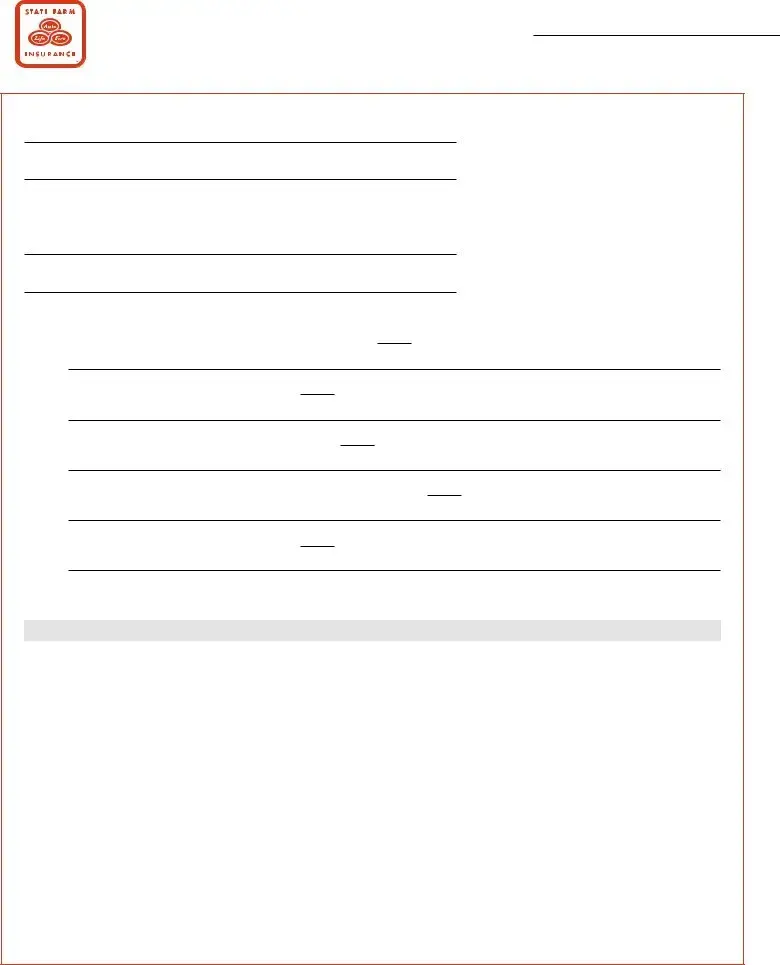statefarm.com/agents/career
Instructions
Personal Financial Statement Instructions
Note: Start with completing the Schedules irst. he totals will carry forward to the Statement. Ater completing ALL applicable sections of the Schedules, please make sure all sections of the Statement are also completed as well.
Schedules
Complete each item as thoroughly as possible and provide all pertinent information requested.
Assets
Assets are things you own that are of monetary value.
·Complete Schedules (1-5) irst, totals will pull forward automatically to Statement.
·Include dollar value/present market value for all items listed as assets.
·“Other Assets” includes anything of monetary value not previously addressed.
·On the Statement, include cash surrender value of life insurance.
·On the Statement, list the number of automobiles owned and the total value of all automobiles.
·On the Statement, include amounts due from others.
·“Total Assets” will calculate automatically.
Liabilities
Liabilities are monies you owe to others.
·Complete Schedules (6-9) irst, totals will pull forward automatically to Statement.
·List outstanding balances on each line item.
·“Other Liabilities” includes any monies you owe to others not previously addressed.
·On Schedule 4, include your mortgage due on real estate/residence.
·On the Statement, include your real estate taxes due.
·On the Statement, include any rents and interest due.
·On the Statement, include any other accounts and notes payable to others.
·“Total Liabilities” will calculate automatically.
Total Net Worth
Total Net Worth is found by subtracting your liabilities from your assets. his will calculate automatically.
This is proprietary information owned by State Farm® and it may be lawfully used only as authorized by appropriate Agency management. 01-04-2011 |
Z-25204 |
statefarm.com/agents/career
Schedules
No. 1 Checking & Savings Accounts (A list of all household checking and savings accounts)
Name and Location |
Cash Balance |
Checking: |
$ |
|
$ |
|
|
Savings: |
$ |
|
$ |
|
|
Total: |
$ |
No. 2 Stocks and Bonds
Description of |
Registered in |
Cost |
Present |
Income Rec’d |
If Pledged State |
Security |
Name of |
|
Market Value |
Last Year |
to Whom |
|
|
$ |
$ |
$ |
|
|
|
|
|
|
|
|
|
$ |
$ |
$ |
|
|
|
|
|
|
|
|
|
$ |
$ |
$ |
|
|
|
|
|
|
|
|
|
$ |
$ |
$ |
|
|
|
|
|
|
|
|
|
$ |
$ |
$ |
|
|
|
|
|
|
|
|
Total: |
$ |
$ |
$ |
|
|
|
|
|
|
|
No. 3 S&T Plan, 401(k), Keogh, etc.
Registered in Name Of |
Present Market Value |
|
$ |
|
|
|
$ |
|
|
|
$ |
|
|
|
$ |
|
|
|
$ |
|
|
Total: |
$ |
No. 4 Real Estate (Solely or partially owned. If partially owned, provide dollar amounts based on percentage owned.)
|
Address / Description |
Purchase |
|
Purchase |
Mortgages |
Present |
|
Payment |
|
|
|
Date |
|
Price |
or Liens |
Market Value |
|
Amount |
|
|
|
|
$ |
|
$ |
$ |
$ |
|
|
|
|
|
|
|
|
|
|
|
|
|
|
|
$ |
|
$ |
$ |
$ |
|
|
|
|
|
|
|
|
|
|
|
|
|
|
|
$ |
|
$ |
$ |
$ |
|
|
|
|
|
|
|
|
|
|
|
|
|
|
|
$ |
|
$ |
$ |
$ |
|
|
|
|
|
|
|
|
|
|
|
|
|
|
|
$ |
|
$ |
$ |
$ |
|
|
|
|
|
|
|
|
|
|
|
|
|
Total: |
|
$ |
|
$ |
$ |
$ |
|
|
|
|
|
|
|
|
|
|
|
|
|
|
|
|
|
|
|
|
|
This is proprietary information owned by State Farm® and it may be lawfully used only as authorized by appropriate Agency management. 01-04-2011 |
Z-25204 |
statefarm.com/agents/career
Schedules
No. 5 Other Assets (excluding Auto(s))
$
$
$
$
$
Total: $
No. 6 Credit Card Balance (Credit Cards in your or your spouse’s name)
Credit Card Name |
Credit |
Current |
Monthly |
|
limit |
Balance |
Payment |
|
$ |
$ |
$ |
|
|
|
|
|
$ |
$ |
$ |
|
|
|
|
|
$ |
$ |
$ |
|
|
|
|
|
$ |
$ |
$ |
|
|
|
|
|
$ |
$ |
$ |
|
|
|
|
|
$ |
$ |
$ |
|
|
|
|
|
$ |
$ |
$ |
|
|
|
|
|
$ |
$ |
$ |
|
|
|
|
|
$ |
$ |
$ |
|
|
|
|
Total: |
$ |
$ |
$ |
No. 7 Notes Payable to Banks (excluding real estate/mortgages) (A list of the amounts owed.)
|
Owed to Whom |
Original |
Balance |
How |
Description of Security |
|
|
|
|
Amount |
Due |
Long? |
Held |
|
|
|
|
$ |
$ |
|
|
|
|
|
|
|
|
|
|
|
|
|
|
$ |
$ |
|
|
|
|
|
|
|
|
|
|
|
|
|
|
$ |
$ |
|
|
|
|
|
|
|
|
|
|
|
|
|
|
$ |
$ |
|
|
|
|
|
|
|
|
|
|
|
|
|
|
$ |
$ |
|
|
|
|
|
|
|
|
|
|
|
|
|
|
$ |
$ |
|
|
|
|
|
|
|
|
|
|
|
|
|
|
$ |
$ |
|
|
|
|
|
|
|
|
|
|
|
|
|
|
$ |
$ |
|
|
|
|
|
|
|
|
|
|
|
|
|
|
$ |
$ |
|
|
|
|
|
|
|
|
|
|
|
|
|
|
$ |
$ |
|
|
|
|
|
|
|
|
|
|
|
|
|
Total: |
$ |
$ |
|
|
|
|
|
|
|
|
|
|
|
|
|
|
|
|
|
|
|
|
This is proprietary information owned by State Farm® and it may be lawfully used only as authorized by appropriate Agency management. 01-04-2011 |
Z-25204 |
statefarm.com/agents/career
Schedules
No. 8 Other Liabilities
$
$
$
$
$
Total: $
Completion and submission of this form certiies that the information provided has been carefully reviewed and is true and correct.
This is proprietary information owned by State Farm® and it may be lawfully used only as authorized by appropriate Agency management. 01-04-2011 |
Z-25204 |
statefarm.com/agents/career
Personal Financial Statement
Name
To: State Farm Insurance Companies
Address
Telephone
Date
Have you or your spouse (if married) ever defaulted on any loan? Y/N
Explain
Do you have an existing interest in any business? Y/N
Explain
Do you have an existing managerial role in any business? Y/N
Explain
Are you or your spouse (if married) the endorser or co-maker of any loans? Y/N
Explain
Are you responsible for any other debt not listed? Y/N
Explain
Assets |
|
Liabilities $ Net Worth |
|
|
|
|
|
|
Savings & Checking Accounts (Schedule No. 1) |
$ |
Mortgage on Real Estate (Schedule No. 4) |
$ |
|
|
|
|
|
Cash Surrender Value of Life Insurance |
$ |
Real Estate Taxes Due |
$ |
|
|
|
|
|
Stocks & Bonds (Schedule No. 2) |
$ |
Rents & Interest Due |
$ |
|
|
|
|
|
S&T Plan, 401(k), Keogh, etc. (Schedule No. 3) |
$ |
Credit Card Balance (Schedule No. 6) |
$ |
|
|
|
|
|
Real Estate (Schedule No. 4) |
$ |
Notes Payable to Banks (Schedule No. 7) |
$ |
Automobiles – Number/Market Value |
|
$ |
Accounts & Notes Payable to Others |
$ |
|
|
|
|
|
Amounts Due from Others |
$ |
Other Liabilities (Schedule No. 8) |
$ |
|
|
|
|
Other Assets (Schedule No. 5) |
$ |
|
|
|
|
|
|
Total Assets: |
$ |
Total Liabilities: |
$ |
|
|
|
|
|
|
|
|
Total Net Worth: |
$ |
|
|
|
|
|
|
|
|
|
|
This is proprietary information owned by State Farm® and it may be lawfully used only as authorized by appropriate Agency management. 01-04-2011 |
Z-25204 |





